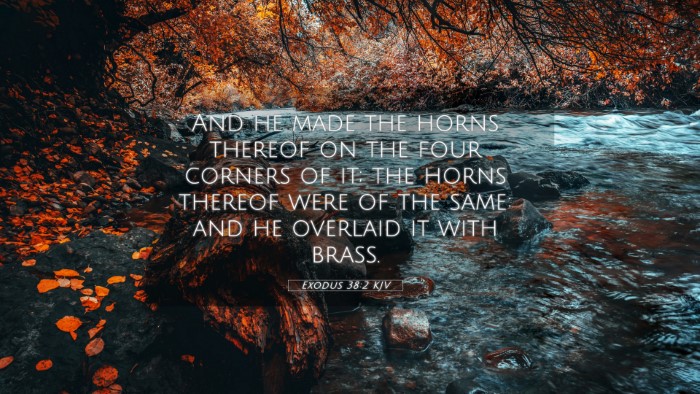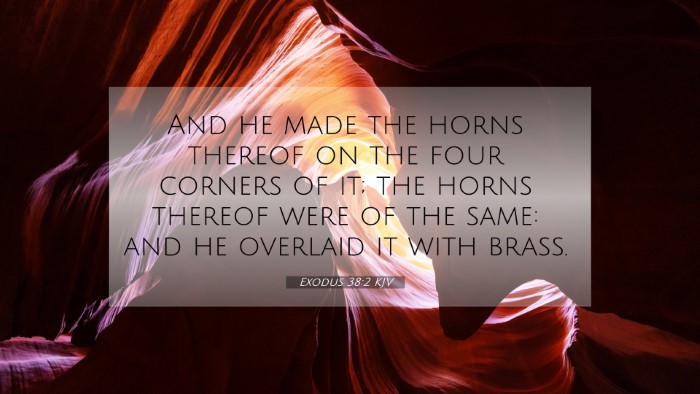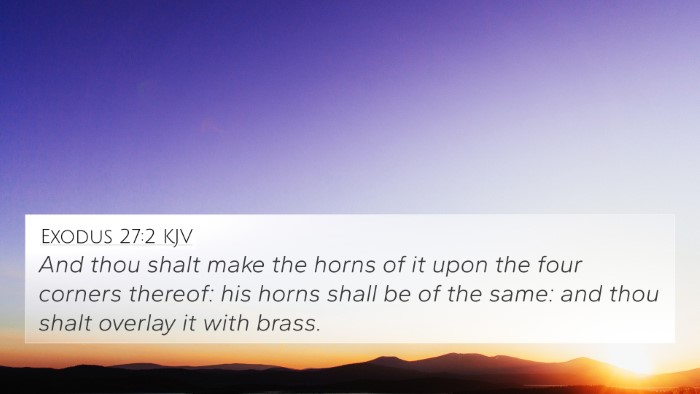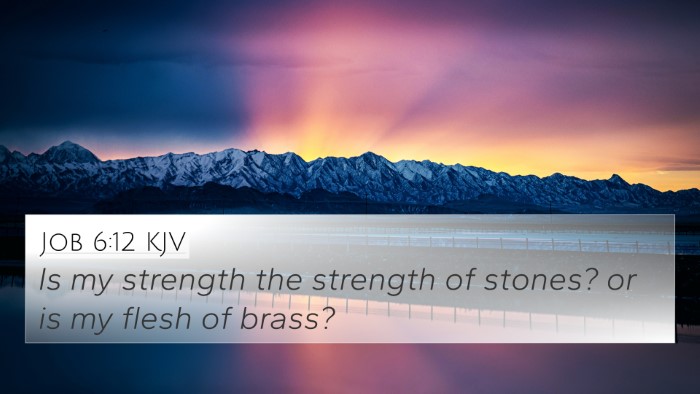Understanding Exodus 38:2
Exodus 38:2 states: "And he made the altar of burnt offering of acacia wood; five cubits was the length thereof, and five cubits the breadth thereof; it was foursquare; and three cubits the height thereof."
This verse describes the construction of the altar of burnt offering as part of the Tabernacle's specifications. The altar was constructed with specific measurements and materials, signifying its importance in worship and sacrifice.
Significance of the Altar
The altar of burnt offering was central to the sacrificial system of the Israelites. It illustrates key themes such as atonement, sacrifice, and divine communion. According to Matthew Henry, this altar served as a significant means for the Israelites to express devotion and seek forgiveness through sacrifices.
Albert Barnes suggests that the specific dimensions of the altar imply that God's instructions are deliberate and precise, emphasizing His holiness and the seriousness of approaching Him through sacrifice.
Adam Clarke elaborates that the choice of acacia wood reflects the durability and resilience of the altar, symbolizing the lasting nature of God's covenant with His people.
Thematic Bible Verse Connections
In studying Exodus 38:2, we can explore various thematic connections across Scripture:
- Leviticus 1:5 - Details the sacrificial process and reinforces the purpose of the altar.
- Hebrews 9:22 - Discusses the necessity of blood for the forgiveness of sins, linking to the type of sacrifices made at the altar.
- Romans 12:1 - Encourages believers to present their bodies as living sacrifices, echoing the principles established in the Old Testament altar system.
- Revelation 8:3 - Presents the altar of incense in heaven, connecting the earthly altar to heavenly worship.
- Matthew 5:23-24 - Highlights the importance of reconciliatory sacrifice, tying back to Old Testament practices.
- John 1:29 - Refers to Jesus as the Lamb of God, whose sacrifice supersedes the offerings made on such altars.
- Exodus 27:1-2 - Provides further details on the dimensions of the altar, enhancing understanding of its significance.
Bible Cross-Reference Benefits
Utilizing a Bible cross-reference guide can help identify the intricate relationships between Exodus 38:2 and other Scriptures. This is essential for:
- Understanding theological implications: Recognizing how sacrifice foreshadows Christ.
- Studying narrative coherence: Seeing how worship practices evolve throughout the biblical narrative.
- Enhancing personal study: Finding deeper meaning through thematic connections.
Tools for Bible Cross-Referencing
For those looking to delve deeper into cross-referencing:
- Bible concordance: A valuable tool for finding scripture references.
- Cross-reference Bible study resources: Materials that offer organized connections between verses.
- Comprehensive Bible cross-reference materials: Books and online resources dedicated to cross-references.
How to Use Bible Cross-References
To effectively utilize a Bible cross-reference system, one might consider the following steps:
- Identify key themes: Focus on recurring messages and motifs.
- Search related verses: Use a concordance to find comparable passages.
- Analyze connections: Look for correlations in meaning, context, and purpose.
- Engage in comparative Bible verse analysis: Examine how different authors convey similar themes.
Conclusion
Exodus 38:2 serves as a foundational verse in understanding the significance of sacrifice in Biblical worship. Through careful study and cross-referencing, one can gain deeper insights into the connections between the Old and New Testaments, enhancing one’s understanding of God’s redemptive plan.
This verse is not just a historical reference but a stepping stone to understanding the broader narrative of Scripture regarding sacrifice, worship, and communion with God.




